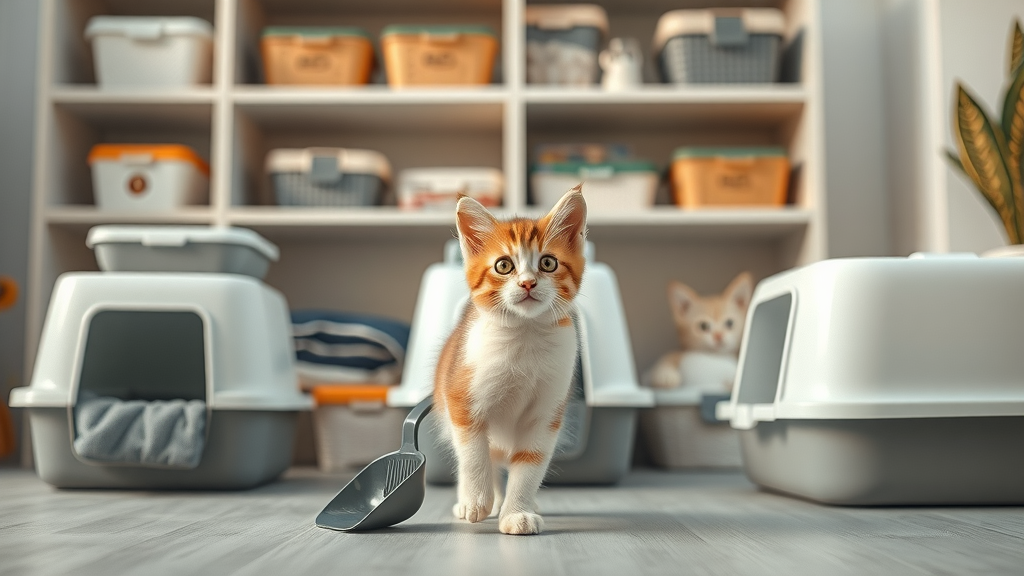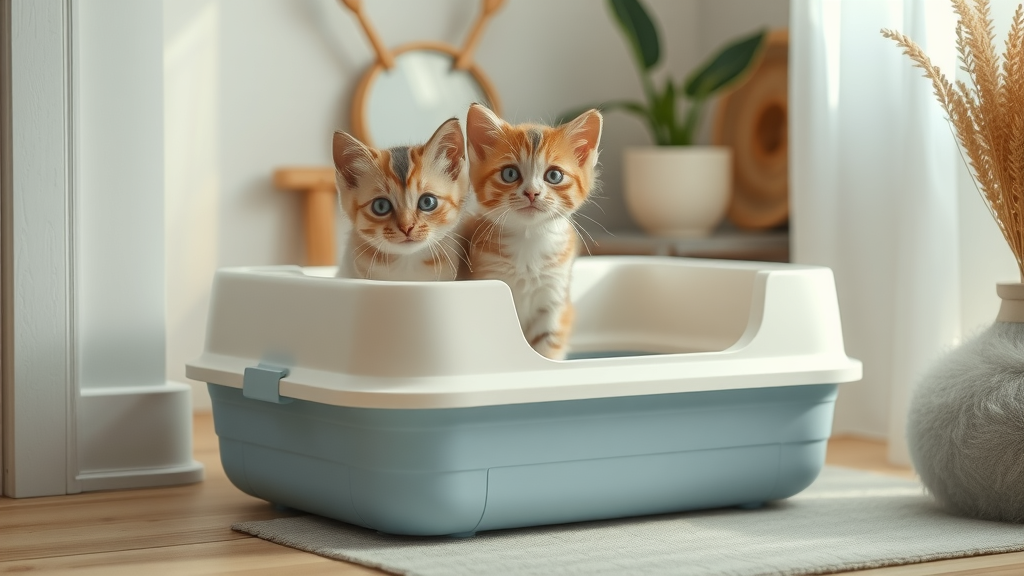Ever wondered, “How do I litter train a kitten?” Maybe you’re worried about mysterious messes around the house, or perhaps you want to ensure your curious new feline friend starts off with perfect habits. This comprehensive guide uncovers tips, secrets, and expert advice on successful litter box training, turning what seems like a daunting challenge into an easy step-by-step process. Dive in and discover how with a little patience, the right supplies, and smart techniques, you can teach your kitten to use the litter box like a pro.
Curious About How Do I Litter Train a Kitten? Unlock the Secrets to Litter Box Success
If you’ve just welcomed an adorable young kitten into your home, you’re likely searching for the best ways to litter train quickly and efficiently. The process of litter training kittens is far simpler than you might expect, especially when you understand how kittens naturally look for a convenient, clean place to eliminate. By providing the right environment and guidance, you’ll find that most kittens adapt to the litter box with surprising speed.
Real-world examples show that a patient, consistent approach helps kittens of all ages—whether a tiny furball fresh from the shelter or an older kitten transitioning from another home. Pet owners who set up multiple, accessible litter boxes and practice positive reinforcement often see results within just a few days. Keep reading to unlock the secrets to litter box training and transform your kitten’s learning curve into a success story.

Understanding the Basics: How Do I Litter Train a Kitten and Why Litter Box Training Matters
Litter box training your kitten is one of the first steps in helping them adapt to indoor life. Cats, even at a young age, prefer a clean, designated place to eliminate , and the litter box provides just that. Without proper training, kittens may develop poor habits or experience stress, which can lead to house soiling issues later on. Understanding these basics lays the foundation for keeping both your home and your feline friend happy.
Providing clear guidance on how to box train your kitten goes beyond cleanliness. It builds mutual trust, helps prevent behavioral challenges, and ensures a smoother transition into adult cat routines. Many adult cats who had early positive litter box experiences are more likely to maintain good habits their entire lives, so investing time in proper box training pays off long-term.
- Why kittens naturally seek out a litter box
- Key reasons to start litter training kittens early
- Health and behavioral benefits of litter box training
- Common mistakes and consequences of improper box train methods
Essential Supplies for Litter Box Training Your Kitten
Setting yourself up for success starts with gathering the right supplies. The quality and placement of the litter boxes greatly affect how quickly and comfortably your kitten adapts. Choose a box that’s low enough for young kittens to climb into easily, and consider starting with unscented, soft, clumping litter —many kittens and adult cats prefer the feel and smell.
In addition to the box and litter, accessories play a valuable role. A lightweight scoop, a small rug or mat to catch stray litter, plus pet-safe cleaners are essential, especially during your kitten’s adjustment period. Remember: having multiple litter boxes in separate areas increases your chances of success, particularly in larger homes or for multiple feline friends.
- Shallow-sided litter box for easy access
- Unscented, clumping litter that most cats prefer
- Litter scoop for quick cleaning
- Waterproof mat to catch spilled litter
- Pet-safe cleaner for quick cleanup of mistakes

Step-by-Step Guide: How Do I Litter Train a Kitten with Positive Reinforcement
Choosing the Right Litter Box and Cat Litter
When it comes to litter training your kitten, selecting the proper litter box and cat litter matters greatly. Young kittens need shallow-sided litter boxes that allow easy entry and exit, while older kittens benefit from slightly larger spaces. Avoid covered boxes at first, as enclosed designs can intimidate a new kitten. Choose unscented, soft, clumping litter since it closely mimics materials found in nature, and most cats prefer it over strong-smelling, pellet, or silica-based litters.
Place the chosen box in a quiet area that’s easy to access—think of a bathroom, spare bedroom, or sheltered hallway. Refrain from putting it near your kitten’s food and water to ensure cleanliness and promote regular use. By giving your feline friend a comfortable, familiar setup, you’re setting the stage for rapid litter box train success.
Optimal Setup for Litter Box Training your Kitten
Creating the right environment is central to effective box training . Start by placing the litter box away from loud noises and heavy foot traffic, yet close to the spaces your kitten frequents—especially when adjusting to a new home. If your home is multi-level or particularly large, add extra boxes to minimize accidents caused by distance or confusion.
A small room setup is ideal in the earliest stages. Confine your kitten to a safe, kitten-proofed area with their litter box , cat bed , food and water . This reinforces predictable routines and gently guides your feline companion to the box whenever necessary. Regular cleaning, using a non-toxic scoop and fresh clumping litter , will encourage constant use and prevent odors from deterring your kitten.

Introducing Your Kitten to the Litter Box
As you begin training your kitten , gently place your new friend in the litter box several times a day—especially immediately after meals, naps, and play sessions. Help your kitten feel comfortable by showing them how to scratch gently at the litter’s surface with their paws. Resist the urge to force or frighten; patience builds lasting confidence.
Observe your kitten closely for signs they need to go—sniffing, circling, or squatting—and direct them to the litter box right away. This consistent guidance is essential during the first days of litter box training , as your kitten learns to associate the box with their natural urge to eliminate. Within a week, many kittens show marked improvement using the box independently.
Consistent Schedule: How Litter Box Train and Box Training Create Good Habits
Routine is the backbone of successful litter box train results. Feed your kitten at regular intervals and promptly escort them to the litter box afterward. This predictability conditions your kitten to go at the right times and strengthens the desired behavior. Kittens as young as three to four weeks of age can start box training with success, so don’t hesitate to begin as soon as your kitten comes home.
Keep the litter box spotless during litter training kittens —scoop solids daily, and dump and refresh the entire box weekly. Most young kittens learn where to go within a few days if the process is unwaveringly consistent. Remember: kittens love predictability. Setting a schedule not only fast-tracks the training process but also eliminates accidental mistakes.
Using Positive Reinforcement When Training Your Kitten
One of the best methods to train a kitten is positive reinforcement . Offer gentle praise, soft petting, or a tiny treat every time your kitten uses the litter box correctly. Avoid punishments: negative reactions can create fear and confusion, making litter training take longer.
Consistently reward good behavior, and you’ll see progress accelerate. Most kittens love to be acknowledged for a job well done, so a cheery voice and a treat go a long way in reinforcing proper box use. Remember, patience is key, and every success deserves a celebration!

Common Mistakes in Litter Training Kittens—And How to Avoid Them
Even well-intentioned kitten parents can trip up during litter box training . A few common mistakes—like using heavily scented or pellet cat litter , neglecting frequent cleaning, or placing the box near noisy appliances—can derail your efforts. Cats are sensitive to their environment, so being proactive about their comfort is essential.
Another pitfall is moving the litter box too often or making it difficult for your kitten to access, especially in a multi-pet household. Overwhelming your kitten with changes or harsh corrections slows progress and can lead to persistent urine or feces accidents outside the designated area. Avoid these errors by focusing on routines and positive associations.
- Using strong-scented or pelleted cat litter
- Letting the litter box become dirty
- Placing box near food and water
- Moving the box around the home too often
- Punishing or scaring your kitten after accidents
Troubleshooting: How Do I Litter Train a Kitten Who’s Having Accidents?
Even after following all the right steps, some kittens may still have occasional accidents. The key is to respond calmly and assess possible triggers—such as a dirty box, the type of cat litter , or sudden changes in the environment. Confine your kitten temporarily to a smaller, easily supervised area to reinforce box habits, and use a pet-safe cleaner to eliminate all odor traces and prevent repeat incidents.
Don’t be discouraged if your box training progress stalls with the occasional setback. By remaining patient, making environmental adjustments, and offering continued encouragement, you can steer your kitten back on track and minimize confusion.
Addressing Frequent Litter Box and House Soiling Issues
House soiling can result from stress, medical problems, or confusion about box location. Rule out medical causes with a veterinarian if urine or feces accidents persist beyond a couple of weeks. If health is not a concern, assess whether the litter boxes are clean, accessible, and filled with a cat litter your kitten enjoys.
If needed, restrict your kitten to a small room with a single litter box and gradually expand their allowed space as they consistently use the box. This method is effective for both young kittens and older kittens developing new routines in a new home.

Adjusting Your Approach to Box Training Stubborn Kittens
If your kitten remains stubborn or indifferent to litter box training , switch up the type of cat litter used—sometimes a simple tweak is all it takes for success. Provide extra encouragement, spend more time observing, and repeat positive reinforcement strategies consistently.
Consult a feline behavior consultant for persistent challenges, as they can offer specialized insights tailored to your kitten’s behaviors and needs. Successful box training is never impossible; sometimes it just requires creativity and a bit of expert guidance to unlock effective solutions.
Advanced Tips: Litter Box Solutions for Multi-Kitten Homes
When caring for multiple kittens, unique litter box strategies are important. Each kitten has individual preferences and may require their own space to avoid competition or anxiety. The rule of thumb is to provide one litter box per cat, plus an additional box, spaced throughout your home. Keep each box impeccably clean to encourage use from all furry family members.
If accidents occur, identify if a particular kitten is struggling and consider briefly separating them to reinforce habits. Monitor box cleanliness, experiment with a variety of cat litter types, and ensure all litter boxes are accessible at all times.
- Set up at least one litter box per kitten, plus one extra
- Place boxes in quiet, low-traffic areas on each level of your home
- Try multiple cat litter types to match individual preferences
- Scoop each box daily—clean boxes increase usage
- Temporarily confine kittens who struggle, and reintroduce slowly to shared space
What Experts Say: Insights on Effective Litter Training Kittens
Professional veterinarians and feline behavior experts agree that patience and encouragement are the cornerstones of effective litter box training . A consistent schedule, alongside positive reinforcement and an inviting, calm environment, significantly increases the success rates for even the most hesitant kittens. Addressing individual quirks and challenges with flexibility, as well as the willingness to try different cat litter types, makes all the difference.
"Patience and praise are crucial, as kittens thrive on a consistent and encouraging environment during litter box training."
People Also Ask: Addressing Popular Litter Training Questions
What is the fastest way to litter train a kitten?
The fastest way to litter train a kitten is to start immediately by placing the kitten in the litter box after each meal, play, or nap, using a shallow box and soft, unscented clumping litter . Keep the box in a quiet spot, and reward every success with treats or praise. Most kittens pick up the habit within days with this consistent, encouraging method.
How long does it take for a kitten to litter train?
On average, kittens can become reliable with the litter box within one week, though some may take a bit longer if they are younger or just settling in. The key is consistency and positive reinforcement—be patient and continue reinforcing good habits daily. If progress is slow, review your setup, litter type, and box cleanliness.
Is it normal for kittens to have toilet accidents?
Yes, it’s normal for kittens to have occasional accidents, especially in the early days of training. This is typically part of the learning process and not a cause for concern unless it becomes a persistent pattern. Addressing the environment, switching cat litter , or seeking advice from a vet can help resolve frequent mishaps.
How do I stop my kitten from peeing and pooping in the house?
Start by ensuring your litter boxes are easily accessible, clean, and filled with a preferred cat litter . Confine the kitten to a smaller space with the box until they consistently use it, and gradually allow access to the rest of the house. Never punish; instead, focus on positive reinforcement, and clean up any accidents thoroughly to remove lingering odors.
Frequently Asked Questions about How Do I Litter Train a Kitten?
Q: At what age should I start litter box training?
A: Start litter training kittens as soon as they can walk steadily, usually by three weeks of age.
Q: How many litter boxes do I need for two kittens?
A: One per kitten, plus one extra—so at least three to avoid competition or stress.
Q: What if my kitten eats the cat litter?
A: Stop using clumping or scented litters and try non-clumping paper-based litter, then consult your veterinarian.
Quick Reference Table: Comparing Litter Boxes and Cat Litters
| Litter Type | Box Style | Pros | Cons |
|---|---|---|---|
| Clumping (Clay-based) | Open, shallow | Easy scooping, most cats prefer , controls odor | Tracking, dust, can be messy for young kittens |
| Non-clumping (Paper-based) | High-sided | Low dust, safe for small kittens, eco-friendly | More frequent full changes needed |
| Pellet (Pine/Corn) | Open or covered box | Natural scent, biodegradable, low tracking | Some kittens dislike texture , can be harder to scoop |
| Crystal (Silica) | Covered box | Good odor control, less frequent scooping | Harsh for sensitive paws, expensive |
Checklist for Success: Training Kittens to Use the Litter Box
- Choose the right cat litter and litter box
- Place each box in a safe, quiet spot
- Scoop daily, deep clean weekly
- Reward every correct use with treats or praise
- Avoid sudden environmental changes
- Never punish; always encourage
- Keep food and water separate from litter area
- Consult a vet or behavior consultant if problems persist
Looking for guidance straight from an expert? Watch this helpful video featuring a veterinarian. See how to introduce your kitten to their new litter box, troubleshoot challenges, and maintain spotless habits—all explained in easy-to-follow, practical steps.
Video Tutorial: Step-by-Step Litter Training for Beginners
Prefer a visual walk-through? Our video tutorial shows you step-by-step, beginner-friendly guidance: from setup and supplies to daily routines and expert tips. Perfect viewing for new kitten parents or those struggling with stubborn learners.
Key Takeaways for How Do I Litter Train a Kitten
Start early, keep the environment gentle and consistent, and always reward with patience and praise. The right supplies, clean habits, and positive reinforcement will ensure litter box train success—helping your kitten become a happy, clean member of your family.
Ready to Join Our Pet Lover’s Community?
Our pack is growing — and you’re invited. 🐶🐱 Subscribe now to get exclusive stories, pet wellness tips, and product deals straight to your inbox.
To enhance your understanding of litter training kittens, consider exploring the following resources:
-
“How To Litter Train a Kitten” ( petmd.com )
-
“How to Litter Train a Kitten in 3 Simple Steps” ( cats.com )
These articles provide detailed guidance on selecting appropriate litter boxes and litter types, establishing effective training routines, and addressing common challenges during the litter training process. By consulting these resources, you can gain valuable insights to ensure a smooth and successful litter training experience for your kitten.
 Add Row
Add Row  Add
Add 




Write A Comment